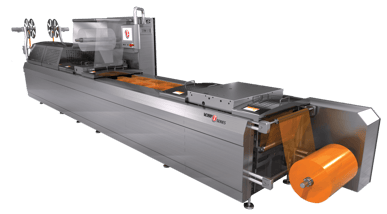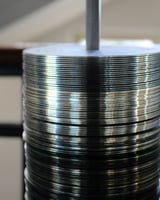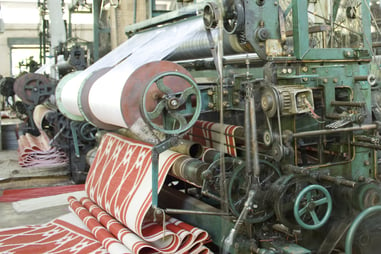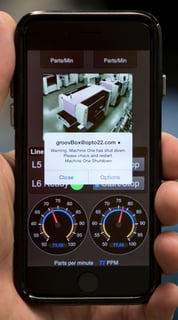
Ahh, the Sixties...
The 1960s was a decade full of inventions, especially innovative new tools that the manufacturing industry would eventually adopt:
- In 1964 the BASIC computer language was invented.
- The following year the compact disc went on sale in the US for a mere $1,000 per unit (maybe that’s why software was so darned expensive).
- 1969 brought us the first barcode scanner.
- And that same year Al Gore invented the Internet, leading to the development of the Industrial Internet of Things as we know it today. Way to go, Al.
The 1960s also brought one of the most important manufacturing industry innovations of all: OEE or Overall Equipment Effectiveness. And today, OEE can help improve just about every manufacturing and production line in the world.
Yes, that means yours, too.

Overall Equipment Effectiveness
One of the best definitions I’ve come across for OEE is from www.industryweek.com: "Put simply, OEE assigns numerical value to improvement opportunity." So it's really about measuring how productive or effective something could be, given the right production variables.
OEE is a metric that identifies the percentage of planned production time that is actually productive. So for any given piece of machinery, one might measure how many products were manufactured correctly the first time and compare that amount to the number the machine should have produced in a given amount of time.
But how does OEE do that exactly? It starts with TPM.
Total Productive Maintenance
Total Productive Maintenance (TPM) is an overall approach to equipment maintenance that strives to achieve "perfect production" by focusing on 3 key objectives:

- No breakdowns
- No small stops or slow running
- No defects
In my experience, all 3 of those objectives are pretty tall orders. Similar to KPIs, OEE was developed to support TPM initiatives by accurately tracking progress towards achieving perfect production. Perfect production means that the manufacturing plant meets all 3 of the above objectives.
Calculating OEE
OEE is a metric derived from 3 other key metrics:
- Availability measures productivity losses from downtime (events that stop planned production for an appreciable amount of time).
- Performance measures losses from slow cycles (factors that cause the process to operate at less than the maximum possible speed).
- Quality measures losses from manufactured parts that do not meet quality requirements.
Together these three factors combine into one OEE score—a single number that provides a complete measure of manufacturing efficiency and effectiveness. OEE is calculated with this formula:
OEE (%) = Availability Rate × Performance Rate × Quality Rate
Let's take a look at the three parts that make up the OEE calculation: availability rate, performance rate, and quality rate.
Availability Rate (the percentage of time the machine is ready to produce, working properly, and not in the midst of changeovers or adjustments) = Available Time (scheduled operating time less downtime) ÷ Scheduled Operating Time.
Performance Rate (the ratio of output produced compared to a standard) = Actual Output ÷ Standard Output.
Quality Rate (the ratio of good output compared to actual output) = Right-first-time Output ÷ Actual Output.
Efficiency and Effectiveness Loss
When trying to reach perfect production, we need some form of measurement to determine how well our manufacturing lines are running and help pinpoint the causes of efficiency and effectiveness loss.
| OEE Metric | Six Big Losses | Example Loss |
|---|---|---|
| Availability Rate | Breakdowns | Machine Failure Unexpected Equipment Breakdown General Maintenance |
| Setup and Adjustment | Changeover Material Shortages Machine Warm-up |
|
| Performance Rate | Speed Losses | Operator Efficiency Machine Wear down Operating Under Capacity |
| Small Stops and Idling | Jams, Blocks, and Obstructions Cleaning Output Checking Misfeeds |
|
| Quality Rate | Production Defects (During Production) | Product Damages and Expiration Scraps |
| Startup Rejects (Before Steady Production) | Improper Assembly Scrap Product Damages |
 Now that we know how to calculate OEE, we can begin to keep track of how efficient and effective our manufacturing lines are.
Now that we know how to calculate OEE, we can begin to keep track of how efficient and effective our manufacturing lines are.
Collecting OEE information and generating an actionable plan can be a time-consuming and labor-intensive task—particularly if information is collected by hand using paper and pencil to build reports.
A much more efficient process is to collect information in real time. Then you can provide the plant floor with KPI information to improve production efficiency and effectiveness during a production run. Much better than tweaking settings months after the run is complete.
A great tool for quickly building an OEE or KPI dashboard is the groov mobile operator interface from Opto 22.
Watch this video to find out what groov can do to improve OEE and KPIs. Or download a free, fully functional trial.

